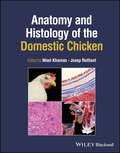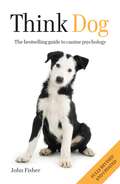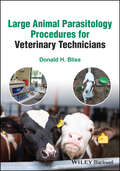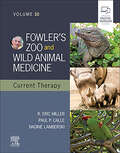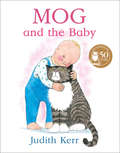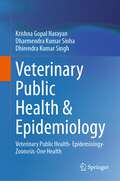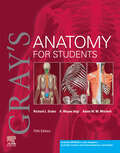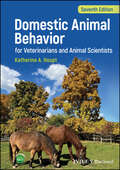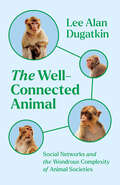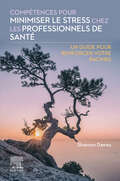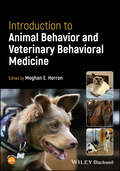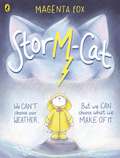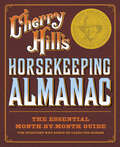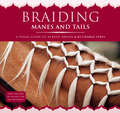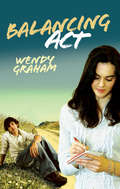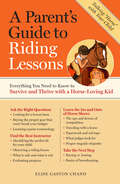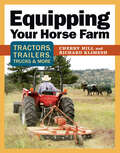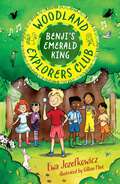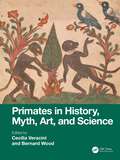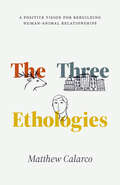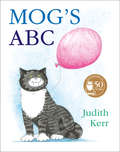- Table View
- List View
Anatomy and Histology of the Domestic Chicken
by Wael Khamas Josep RutllantComprehensive reference describing in-depth physical anatomy and histology of domestic avian species chicken, depicted through high quality macro- and micro-photographs Atlas of Anatomy and Histology of the Domestic Chicken is a state-of-the-art atlas of avian anatomy that provides a complete collection of both original gross anatomy and histology photographs and texts of all body systems of the birds based on the domestic chicken to depict anatomic features. Using cutting-edge technology to create visualizations of anatomic structure, this specialist reference includes both gross anatomical structures/organs and their histological details next to each other. This approach enables readers to understand the macro- and micro-pictures of each organ/structure under study. The text includes a total of more than 200 high-resolution, high quality color images and diagrams. Written by two highly qualified professors with significant experience in the field, Anatomy and Histology of the Domestic Chicken includes information on: External features of the body, including regions, features, ornaments, shape, feathers, skin, and the uropygial gland Musculoskeletal characteristic including cartilage and bone formation and classification, flight and ambulatory muscles Digestive system, including the beak, esophagus, crop, proventriculus, ventriculus, intestines, and accessory glands Respiratory system, including external nares, the nasal cavity, trachea, upper larynx, syrinx, lungs, and air sacs Urinary system, including kidneys and the ureter, cloaca-urodeum, and genital system, covering differences between males and females Endocrine system, including pituitary, pineal, adrenal, pancreas, thyroid, and parathyroid glands Nervous system with central and peripheral divisions and sense organs including eye and ear Lymphatic system, with descriptions of the primary and secondary lymphatic organs Egg anatomy and development of the chick embryo Applied anatomical concepts important for clinical maneuvers and necropsy With comprehensive coverage of the subject and highly detailed photographs included throughout the text, Anatomy and Histology of the Domestic Chicken is an indispensable resource for breeders, veterinarians, researchers, avian biologists, pathologists, and students in animal sciences and veterinary fields.
Think Dog: The bestselling guide to canine psychology
by John FisherIn this seminal pet psychology book, John Fisher examines the mind of the dog with examples taken from his practical experience, with the aim of explaining to owners how the world appears from a dog's point of view.The first section of the book traces the ancestry and inherent behaviour of dogs, from their origins as pack animals related to the wolf or the jackal. The second part examines what most people describe as problem behaviour, which is just normal canine behaviour exhibited in the wrong place. The book concludes with an A-Z of common problems, their causes and cures.In the 1980s and 1990s John Fisher revolutionised dog training, first in England, then in the US. With his self-deprecating manner and 'Oh! So British' sense of humour he taught us to 'Think Dog'.
Large Animal Parasitology Procedures for Veterinary Technicians
by Donald H. BlissLarge Animal Parasitology Procedures for Veterinary Technicians Comprehensive illustrated reference on parasitic nematodes, cestodes, coccidian oocysts and trematode egg recoveries, identification, and enumeration with treatment strategies for five separate categories of animal patients Large Animal Parasitology Procedures for Veterinary Technicians illustrates, in detail, the most sensitive diagnostic procedure for internal parasites of domestic animals using the Modified Wisconsin Sugar Flotation Method. With step-by-step pictures and bullet-point instructions, this text discusses sample collection and storage techniques, as well as the strengths and weaknesses inherent to other commonly used tests. Potential sources for infection, the seasonality of the infection, possible environmental recontamination, and control strategies are all covered in detail, with suggestions to prevent reoccurrences. Parasites of the equine, large and small ruminants (including alpaca), swine, poultry and hoofed wildlife patients are included, with full color images for quick identification, an assessment of life cycle stage, and discussion of zoonotic potential. Each species section is heavily illustrated with comparative images to aid the technician in quickly identifying the parasite and life cycle stage. In Large Animal Parasitology Procedures for Veterinary Technicians, readers can find information on: The definition and economic importance of parasitisms, details on the epidemiology of parasitic enteritis, including basics of protozoology, helminthology, and overall applied veterinary parasitology Sample collection and shipment of specimens, including collection, storage, examinations, and interpretations Fecal examination using the Modified Wisconsin Sugar Flotation method, compared with gross examination, smear, sedimentation, and other flotation techniques, plus a fluke egg recovery technique and the Baermann technique for lungworm larvae recovery Internal parasite diagnosis and worm egg recoveries, descriptions and pictures of nematode parasite eggs (as well as coccidia oocysts), plus tapeworm eggs and fluke egg descriptions and photos for a variety of host animals Illustrating commonly used diagnostic tests in veterinary parasitology, with step-by-step instructions for accuracy, Large Animal Parasitology Procedures for Veterinary Technicians is an essential reference for veterinary technicians and veterinary technician students dealing with domestic animals, including horses, ruminants, swine, poultry, and hoofed wildlife.
Large Animal Parasitology Procedures for Veterinary Technicians
by Donald H. BlissLarge Animal Parasitology Procedures for Veterinary Technicians Comprehensive illustrated reference on parasitic nematodes, cestodes, coccidian oocysts and trematode egg recoveries, identification, and enumeration with treatment strategies for five separate categories of animal patients Large Animal Parasitology Procedures for Veterinary Technicians illustrates, in detail, the most sensitive diagnostic procedure for internal parasites of domestic animals using the Modified Wisconsin Sugar Flotation Method. With step-by-step pictures and bullet-point instructions, this text discusses sample collection and storage techniques, as well as the strengths and weaknesses inherent to other commonly used tests. Potential sources for infection, the seasonality of the infection, possible environmental recontamination, and control strategies are all covered in detail, with suggestions to prevent reoccurrences. Parasites of the equine, large and small ruminants (including alpaca), swine, poultry and hoofed wildlife patients are included, with full color images for quick identification, an assessment of life cycle stage, and discussion of zoonotic potential. Each species section is heavily illustrated with comparative images to aid the technician in quickly identifying the parasite and life cycle stage. In Large Animal Parasitology Procedures for Veterinary Technicians, readers can find information on: The definition and economic importance of parasitisms, details on the epidemiology of parasitic enteritis, including basics of protozoology, helminthology, and overall applied veterinary parasitology Sample collection and shipment of specimens, including collection, storage, examinations, and interpretations Fecal examination using the Modified Wisconsin Sugar Flotation method, compared with gross examination, smear, sedimentation, and other flotation techniques, plus a fluke egg recovery technique and the Baermann technique for lungworm larvae recovery Internal parasite diagnosis and worm egg recoveries, descriptions and pictures of nematode parasite eggs (as well as coccidia oocysts), plus tapeworm eggs and fluke egg descriptions and photos for a variety of host animals Illustrating commonly used diagnostic tests in veterinary parasitology, with step-by-step instructions for accuracy, Large Animal Parasitology Procedures for Veterinary Technicians is an essential reference for veterinary technicians and veterinary technician students dealing with domestic animals, including horses, ruminants, swine, poultry, and hoofed wildlife.
Fowler's Zoo and Wild Animal Medicine Current Therapy, Volume 10: Fowler's Zoo and Wild Animal Medicine Current Therapy, Volume 10 - E-Book
by R. Eric Miller Paul P. Calle Nadine LamberskiGet the latest advances in zoo and wild animal medicine in one invaluable reference! Written by internationally recognized experts, Fowler's Zoo and Wild Animal Medicine: Current Therapy, Volume 10 provides a practical guide to the latest research and clinical management of captive and free-ranging wild animals. For each animal, coverage includes topics such as biology, anatomy and special physiology, reproduction, restraint and handling, housing requirements, nutrition and feeding, surgery and anesthesia, diagnostics, and treatment protocols. New topics in this edition include holistic treatments, antibiotic resistance in aquariums, non-invasive imaging for amphibians, emerging reptile viruses, and African ground hornbill medicine, in addition to giant anteater medicine, Brucella in marine animals, and rhinoceros birth parameters. With coverage of many subjects where information has not been readily available, Fowler’s is a resource you don’t want to be without. Fowler's Current Therapy format ensures that each volume in the series covers all-new topics with timely information on current topics of interest in the field. Focused coverage offers just the right amount of depth — often fewer than 10 pages in a chapter — which makes the material easier to access and easier to understand. General taxon-based format covers all terrestrial vertebrate taxa plus selected topics on aquatic and invertebrate taxa. Updated information from the Zoological Information Management System (ZIMS) includes records from their growing database for 2.3 million animals (374,000 living) and 23,000 taxa, which can serve as a basis for new research. Expert, global contributors include authors from the U.S. and 25 other countries, each representing trends in their part of the world, and each focusing on the latest research and clinical management of captive and free-ranging wild animals. NEW! All-new topics and contributors ensure that this volume addresses the most current issues relating to zoo and wild animals. NEW! Content on emerging diseases includes topics such as COVID-19, rabbit hemorrhagic disease, yellow fever in South American primates, monitoring herpesviruses in multiple species, and canine distemper in unusual species. NEW! Emphasis on management includes coverage of diversity in zoo and wildlife medicine. NEW! Panel of international contributors includes, for the first time, experts from Costa Rica, Estonia, Ethiopia, India, Norway, and Singapore, along with many other countries. NEW! Enhanced eBook version is included with each print purchase, providing a fully searchable version of the entire text and access to all of its text, figures, and references.
Mog and the Baby
by null Judith KerrShare in fifty years of a really remarkable cat… Mog is everyone’s favourite family cat! Join her in this warm-hearted and funny escapade about Mog’s first meeting with a baby… as read by Tacy Kneale, and as a full-colour ebook! Celebrate the fiftieth anniversary of Mog the Forgetful Cat with special anniversary editions of her much-loved adventures. From the creator of The Tiger Who Came to Tea and Mog the Forgetful Cat comes a delightful family adventure about a really remarkable cat! Read by Tacy Kneale and as a full-colour ebook. Mog's peaceful day is shattered when a baby comes to visit. All Mog wants to do and sleep and play but there is no chance of that now… "Mog loves babies," says Mrs Thomas but suddenly Mog isn't quite so sure! Mog the Forgetful Cat was first published fifty years ago, and Mog has been delighting children all over the world with her adventures ever since. These books are the perfect gifts for boys, girls and families everywhere!
Veterinary Public Health & Epidemiology: Veterinary Public Health- Epidemiology-Zoonosis-One Health
by Krishna Gopal Narayan Dharmendra Kumar Sinha Dhirendra Kumar SinghThis book introduces and reviews the essential principles of Veterinary Public Health, Zoonoses, One Health, principles and applications of epidemiology in studying infectious diseases including foodborne infections and intoxications. The initial chapters discuss the concept and principal functions of Veterinary Public Health. The book further covers the impacts of Veterinary Public Health on human Health particularly in management of zoonoses. The following section discusses theapplication of epidemiology in the study of outbreaks, epidemic, pandemics and their prevention and control strategies. It helps understanding the factors associated with disease causation transmission and spread and also investigate the emergence of antimicrobial resistance. The chapter on foodborne illnesses illustrates how the knowledge of epidemiology is applied in the study of diseases in community, spread of causative agents from farm to fork. The definition, cause, symptoms, management, control and prevention of foodborne infection and intoxication are dealt with.The last chapter introduces the concept, objectives, and definition of One Health and discusses the advancements made and challenges in One Health around endemic and emerging zoonotic diseases.
Gray's Anatomy for Students E-Book: Gray's Anatomy for Students E-Book (Gray's Anatomy)
by Richard L. Drake A. Wayne Vogl Adam W.M. MitchellConcise, readable text and an outstanding art program make Gray's Anatomy for Students, 5th Edition, your go-to text for essential information in human anatomy. This fully revised volume focuses on the core information medical students need to know, in an easy-access format and with additional multimedia content to facilitate effective study and mastery of the material. A team of expert authors share a wealth of diverse teaching and clinical experience—all enhanced by more than 1,000 innovative, original illustrations by renowned illustrators Richard Tibbitts and Paul Richardson, who capture anatomical features with unrivalled clarity. Helps you understand the practical applications of anatomical concepts through unique coverage of surface anatomy, correlative diagnostic images, and clinical case studies. Contains increased representation of diverse population groups throughout, incorporating a wider range of skin tones and important clinical considerations related to transgender and intersex individuals. Presents anatomy logically by body region – as well as bonus updated eBook chapters for each major body system to facilitate learning from a different perspective. Includes new and improved online materials such as self-assessment questions, medical and physical therapy clinical cases, a unique Interactive Surface Anatomy tool, and more. Provides fully revised and updated clinical content including numerous new In the Clinic boxes, images, and correlates throughout that reflect the latest advances seen in clinical practice. New and updated Clinical Cases are included in the accompanying enhanced eBook. Features an updated neuroanatomy eBook chapter, so you can learn key aspects of this challenging topic in the context of general anatomy. Improves comprehension of complex cranial nerves with a visual map summarizing cranial nerve distribution and function. Offers schematic drawings for key structures and topics in every chapter, providing an additional, simplified approach to introduce each topic—ideal for quick initial understanding and as a guide for your own anatomy drawings. Enables you to quickly review the basic concepts from each chapter with Conceptual Overviews. Evolve Instructor site with a downloadable image bank is available to instructors through their Elsevier sales rep or via request at https://evolve.elsevier.com.
Domestic Animal Behavior for Veterinarians and Animal Scientists
by Katherine A. HouptFully updated revision of a classic text offering a thorough understanding of the normal behavior of domestic animals The Seventh Edition of Domestic Animal Behavior for Veterinarians and Animal Scientists is a fully updated revision of this popular, classic text offering a thorough understanding of the normal behavior of domestic animals. Maintaining the foundation of earlier editions, chapters examine key behavior issues ranging from communication to social structure. The Seventh Edition adds enhanced coverage of behavioral genetics, animal cognition, and learning, considering new knowledge and the very latest information throughout. Each chapter covers a wide variety of farm and companion animals, including dogs, cats, horses, pigs, sheep, cattle, and goats. Major additions are chicken and donkey behavior as well as the microbiome. Each chapter covers a particular behavior subdivided by species. The information has been updated using information published in the past five years. To aid in reader comprehension and assist in self-learning, a companion website provides review questions and answers and the figures from the book in PowerPoint. Sample topics covered in Domestic Animal Behavior for Veterinarians and Animal Scientists include: Communication patterns, perception, vocalization, visual signals, social behavior, sleep and activity patterns, and detection of emotions in others Maternal behavior, pain- and fear-induced aggression, feeding habits, and behavioral problems (such as cribbing, offspring rejection and anxiety) Aggression and social structure, stereotypic behavior, free-ranging versus confined behavior, and maternal behavior (such as recognizing the young) Sexual behavior, development of behavior, and sleep behavior, including ultradian, circadian, annual, and other rhythms Ingestive behavior (food and water intake), hyperactivity and narcolepsy, and overall learning behavior The role of genetics, the environment, and the microbiome in behavior The Seventh Edition of Domestic Animal Behavior for Veterinarians and Animal Scientists is an essential reference for students of animal science and veterinary students, as well as qualified veterinarians and animal scientists seeking a more thorough understanding of the principles of animal behavior.
Domestic Animal Behavior for Veterinarians and Animal Scientists
by Katherine A. HouptFully updated revision of a classic text offering a thorough understanding of the normal behavior of domestic animals The Seventh Edition of Domestic Animal Behavior for Veterinarians and Animal Scientists is a fully updated revision of this popular, classic text offering a thorough understanding of the normal behavior of domestic animals. Maintaining the foundation of earlier editions, chapters examine key behavior issues ranging from communication to social structure. The Seventh Edition adds enhanced coverage of behavioral genetics, animal cognition, and learning, considering new knowledge and the very latest information throughout. Each chapter covers a wide variety of farm and companion animals, including dogs, cats, horses, pigs, sheep, cattle, and goats. Major additions are chicken and donkey behavior as well as the microbiome. Each chapter covers a particular behavior subdivided by species. The information has been updated using information published in the past five years. To aid in reader comprehension and assist in self-learning, a companion website provides review questions and answers and the figures from the book in PowerPoint. Sample topics covered in Domestic Animal Behavior for Veterinarians and Animal Scientists include: Communication patterns, perception, vocalization, visual signals, social behavior, sleep and activity patterns, and detection of emotions in others Maternal behavior, pain- and fear-induced aggression, feeding habits, and behavioral problems (such as cribbing, offspring rejection and anxiety) Aggression and social structure, stereotypic behavior, free-ranging versus confined behavior, and maternal behavior (such as recognizing the young) Sexual behavior, development of behavior, and sleep behavior, including ultradian, circadian, annual, and other rhythms Ingestive behavior (food and water intake), hyperactivity and narcolepsy, and overall learning behavior The role of genetics, the environment, and the microbiome in behavior The Seventh Edition of Domestic Animal Behavior for Veterinarians and Animal Scientists is an essential reference for students of animal science and veterinary students, as well as qualified veterinarians and animal scientists seeking a more thorough understanding of the principles of animal behavior.
The Well-Connected Animal: Social Networks and the Wondrous Complexity of Animal Societies
by Lee Alan DugatkinAn engaging exploration of the wondrous social webs that permeate life in animal societies around the world. It’s all about who you know. Whether vampire bats sharing blood meals for survival, field crickets remembering champion fighters, macaque monkeys forming grooming pacts after a deadly hurricane, or great tit birds learning the best way to steal milk—it pays to be well connected. In this tour of the animal kingdom, evolutionary biologist Lee Alan Dugatkin reveals a new field of study, uncovering social networks that existed long before the dawn of human social media. He accessibly describes the latest findings from animal behavior, evolution, computer science, psychology, anthropology, genetics, and neurobiology, and incorporates interviews and insights from researchers he finds swimming with manta rays, avoiding pigeon poop, and stopping monkeys from stealing iPads. With Dugatkin as our guide, we investigate social networks in giraffes, elephants, kangaroos, Tasmanian devils, whales, bats, and more. From animal networks in Australia and Asia to Africa, Europe, and the Americas, The Well-Connected Animal is an eye-opening exposé of wild friends, enemies, and everything in between.
The Well-Connected Animal: Social Networks and the Wondrous Complexity of Animal Societies
by Lee Alan DugatkinAn engaging exploration of the wondrous social webs that permeate life in animal societies around the world. It’s all about who you know. Whether vampire bats sharing blood meals for survival, field crickets remembering champion fighters, macaque monkeys forming grooming pacts after a deadly hurricane, or great tit birds learning the best way to steal milk—it pays to be well connected. In this tour of the animal kingdom, evolutionary biologist Lee Alan Dugatkin reveals a new field of study, uncovering social networks that existed long before the dawn of human social media. He accessibly describes the latest findings from animal behavior, evolution, computer science, psychology, anthropology, genetics, and neurobiology, and incorporates interviews and insights from researchers he finds swimming with manta rays, avoiding pigeon poop, and stopping monkeys from stealing iPads. With Dugatkin as our guide, we investigate social networks in giraffes, elephants, kangaroos, Tasmanian devils, whales, bats, and more. From animal networks in Australia and Asia to Africa, Europe, and the Americas, The Well-Connected Animal is an eye-opening exposé of wild friends, enemies, and everything in between.
Compétences pour minimiser le stress chez les professionnels de santé - E-BOOK: Compétences pour minimiser le stress chez les professionnels de santé - E-BOOK
by Shannon DamesDéveloppez la résilience et prospérez en tant que professionnel des soins ! Compétences pour minimiser le stress chez les professionnels de santé : un guide pour renforcer votre racines aborde des méthodes pour prendre soin de soi et prévenir la fatigue émotionnelle et l’épuisement professionnel dans les milieux de travail très stressants. Ce livre utilise une approche factuelle qui examine comment les professionnels de la santé peuvent développer l’autocompassion, la pleine conscience, les relations avec leurs collègues et leur satisfaction en leur carrière. Rédigé par Shannon Dames, enseignante et chercheuse réputée, ce manuel pratique montre comment mettre en pratique ces connaissances et améliorer votre bien-être dans de vrais contextes de soins. En raison de la prévalence plus élevée chez les professionnels de la santé de problèmes de santé mentale comme le syndrome de stress post-traumatique (SSPT) et le trouble dépressif majeur (TDM) une ressource comme celle-ci n’a jamais été aussi nécessaire !Focaliser à la fois sur la théorie et la pratique permet aux étudiants de s’autoévaluer, de renforcer leur résilience et de s’épanouir, grâce à des concepts soutenus par la recherche.UNIQUE ! Les études de cas Parcours illustrent l’expérience ou les préoccupations réelles d’un professionnel de la santé, ce qui amène les étudiants à réfléchir, pendant leur lecture, à la façon dont ils géreraient la situation exposée. La fin du chapitre propose une méthode efficace pour gérer la situation, et démontre comment mettre en pratique les leçons apprises.UNIQUE ! L’écriture claire sur le ton de la conversation et le cadre métaphorique des racines et de l’arbre établissent un lien avec les lecteurs et facilitent l’apprentissage conceptuel.Des exercices pratiques intégrés permettent aux étudiants de développer et de renforcer leurs propres racines métaphoriques.Des vignettes tout au long du texte démontrent comment les concepts s’appliquent aux scénarios du monde réel.S’adapter au parcours à venir résume le contenu à la fin de chaque chapitre pour que les étudiants comprennent bien les concepts principaux.UNIQUE ! Des encadrés présentant la contribution du Dr Crosbie Watler, M.D., FRCPC aident les étudiants à naviguer et à comprendre les enjeux en santé mentale qui touchent les professionnels de la santé.
Introduction to Animal Behavior and Veterinary Behavioral Medicine
by Meghan E. HerronIntroduction to Animal Behavior and Veterinary Behavioral Medicine Understand and apply key concepts of animal behavior in veterinary practice Animal behavior is a critical aspect of veterinary medicine, often underappreciated despite its pervasiveness throughout the field. Understanding animal behavior can facilitate communication with patients, refine diagnoses and indications of ill health, and aid in processes of learning and socialization. Introduction to Animal Behavior and Veterinary Behavioral Medicine offers a comprehensive overview of the key concepts underlying the behavior of multiple animal species before demonstrating how to apply these concepts clinically. The result is an indispensable resource for veterinary students and practitioners who want to deepen their understanding of patient needs. Introduction to Animal Behavior and Veterinary Behavioral Medicine readers will also find: Comprehensive coverage of companion animal behavior and additional coverage of livestock and wild animal behavior Detailed discussion of topics including social development, animal learning, and applied behavior analysis In depth review of diagnosis and treatment strategies for common behavior disorders in companion animals, extending to various additional species Companion website with videos, handouts for downloading, and links to pertinent scientific articles and informative websites Introduction to Animal Behavior and Veterinary Behavioral Medicine is ideal preparation for veterinary medical students as part of “day one readiness” in their professional careers, as well as veterinary practitioners looking for a solid foundation in animal behavior and the treatment of key issues.
Storm-Cat: A first-time feelings picture book
by Magenta FoxWe can't choose our weather, but we can choose what we make of it.Arwel is having a fine day. Yes, his sister has gone off to school for the first time, leaving him alone, and yes, there's a cloud above his head. But he is fine, really he is...But the cloud grows, looms, gets in his way - until Arwel has to admit: there's a Storm-Cat outside and it's waiting for him!But after a spectacular storm comes the comforting calm in this special picture-book debut from the illustrator of Zadie Smith and Nick Laird's Weirdo.
Cherry Hill's Horsekeeping Almanac: The Essential Month-by-Month Guide for Everyone Who Keeps or Cares for Horses
by Cherry HillKeep your horse happy and healthy throughout the entire year. Veteran trainer Cherry Hill provides a comprehensive month-by-month guide to horse care that includes seasonal stable chores and maintenance procedures that promote equine health. Reminding you to check for ticks in April, buy hay in July, and set up winter bedding in October, each month&’s reference charts, to-do lists, and climate notes will help you establish routines that follow the natural cycles of the animals and the land.
Braiding Manes and Tails: A Visual Guide to 30 Basic Braids
by Charni LewisGive your horse a gorgeous look! Charni Lewis provides step-by-step instructions for 30 mane and tail braids for both casual outings and specialized events of all riding styles. Full-color photographs and detailed illustrations bring every twist and turn to life, while also clearly demonstrating proper hand positioning. Get inspired and experiment with a Scalloped mane braid or a Four-Strand Weave for the tail. Not only will your horse look great, the time you spend braiding will help develop that special bond between you and your horse.
Balancing Act
by Wendy GrahamFourteen-year-old Josie is talkative, impulsive and awkward. She desperately wants to fit in at school, but the kids think it’s weird that she’s always counting things. And constantly wiping things clean. And avoiding lifts and packed trains. During visits to the city to see her therapist, Josie becomes besotted with a city busker. She fantasizes about him and travels into town to watch his performances at every opportunity. One day Josie’s life begins to overlap with that of Macka, another school outcast. Macka is quiet, sharp-eyed and takes a while to trust people. A bit like the wedge-tail eagles and other birds of prey he trains after school at the Wildlife Haven. While Josie is besotted with the busker, Macka finds himself besotted with Josie. The two soon realise their lives are following similar paths, which causes a series of misunderstandings and missed opportunities, but also helps each develop a sense of self-worth. Written in a lively and humorous style whilst also invoking compassion and empathy for young people who don't fit in, BALANCING ACT by Wendy Graham is a well-rounded and powerful story of finding and accepting yourself.
A Parent's Guide to Riding Lessons: Everything You Need to Know to Survive and Thrive with a Horse-Loving Kid
by Elise Gaston ChandIf you don&’t know the difference between a bridle and a saddle but your child dreams of riding horses, this informative guide will answer all of your most pressing questions. Elise Gaston Chand provides informed and sensible tips on finding qualified instructors, the cost of lessons, safety concerns, and much more. Learn what to watch for as your child&’s riding progresses, confidently steer your child toward rewarding competition experiences, and take pride in all of your child&’s riding achievements.
Equipping Your Horse Farm: Tractors, Trailers, Trucks & More
by Cherry Hill Richard KlimeshRunning a horse farm requires acquiring, operating, and maintaining an assortment of heavy machinery. This practical guide shows you how to expertly equip your operation with trucks, trailers, tractors, and more. Learn how to compare models, select machines appropriate to your needs, troubleshoot problems, and work with attachments like loaders, disc harrows, and manure spreaders. Using the right machinery will help you work more efficiently, save you money, and leave you more time to spend with your horses.
Benji's Emerald King (The Woodland Explorers Club #1)
by Ewa JozefkowiczThe Woodland Explorers solve mysteries and protect the animals of Willow Wish Woods. A magical new series for 5-7 inspired by Forest School, by prize-shortlisted author Ewa Jozefkowicz, full of friendship, adventure, and learning through nature, with fun illustrations on every page.In Willow Wish Woods stands the ancient Emerald King. It is the tallest tree in the forest and there's something special about it. Something magic... Benji, Shyla, Ajay, Trix, Fujiko and Eric discover its branches are damaged. Who could have hurt the tree, and why? The stream, the Tadpole Run, is full of rubbish, and there's not a frog in sight. The friends decide to form the Woodland Explorers Club. Their mission is to solve the mystery of the Emerald King, protect the animals of Willow Wish Woods and bring the magic of the forest back to life.Join the Explorers on their next adventure, Shyla's Wood Wide Web publishing in November 2024!
Primates in History, Myth, Art, and Science
by Cecilia Veracini Bernard WoodNon-human primates (hereafter just primates) play a special role in human societies, especially in regions where modern humans and primates co-exist. Primates feature in myths and legends and in traditional indigenous knowledge. Explorers observed them in the wild and brought them, at great cost, to Europe. There they were valued as pets and for display, their images featured in art and architecture, and where they were literally teased apart by scientists. The international team of contributors to this book draws these different perspectives together to show how primates helped humans better understand their own place in nature. The book will be of interest to undergraduate and graduate students as well scholars in disciplines ranging from anthropology to art history.Key features: Includes contributions from an international team of historians and natural scientists Integrates various perspectives and perceptions of non-human primates across time and place Summarizes the place of non-human primates in science, art and culture Includes rare early illustrations
Primates in History, Myth, Art, and Science
by Cecilia Veracini Bernard WoodNon-human primates (hereafter just primates) play a special role in human societies, especially in regions where modern humans and primates co-exist. Primates feature in myths and legends and in traditional indigenous knowledge. Explorers observed them in the wild and brought them, at great cost, to Europe. There they were valued as pets and for display, their images featured in art and architecture, and where they were literally teased apart by scientists. The international team of contributors to this book draws these different perspectives together to show how primates helped humans better understand their own place in nature. The book will be of interest to undergraduate and graduate students as well scholars in disciplines ranging from anthropology to art history.Key features: Includes contributions from an international team of historians and natural scientists Integrates various perspectives and perceptions of non-human primates across time and place Summarizes the place of non-human primates in science, art and culture Includes rare early illustrations
The Three Ethologies: A Positive Vision for Rebuilding Human-Animal Relationships (Animal Lives)
by Matthew CalarcoA transformative vision for human-animal relations on personal, social, and environmental levels. The Three Ethologies offers a fresh, affirmative vision for rebuilding human-animal relations. Venturing beyond the usual scholarly and activist emphasis on restricting harm, Matthew Calarco develops a new philosophy for understanding animal behavior—a practice known as ethology—through three distinct but interrelated lenses: mental ethology, which rebuilds individual subjectivity; social ethology, which rethinks our communal relations; and environmental ethology, which reconfigures our relationship to the land we co-inhabit with our animal kin. Drawing on developments in philosophy, (eco)feminist theory, critical geography, Indigenous studies, and the environmental humanities, Calarco casts an inspiring vision of how ethological living can help us to reimagine our ideas about goodness, truth, and beauty.
Mog’s Amazing Birthday Caper: ABC
by null Judith KerrShare in fifty years of a really remarkable cat… Mog is everyone’s favourite family cat! Join her in this warm-hearted and funny alphabet adventure, when everything goes wrong at a birthday party… Now in full-colour ebook with optional read-along recording by Andrew Sachs. From the creator of The Tiger Who Came to Tea and Mog the Forgetful Cat comes a delightful family adventure about a really remarkable cat! On the day of Debbie’s birthday party, Mog sets off on an adventure through the alphabet, filled with dragons in the dark and the jaguar with a jug of jelly. M is for Mog, but also for the mad mouse monster! The perfect Mog adventure for learning the alphabet. Mog the Forgetful Cat was first published fifty years ago, and Mog has been delighting children all over the world with her adventures ever since. These books are the perfect gifts for boys, girls and families everywhere! [Note that audio content may be dependent on the functionality of your ebook reader. Download a sample, where possibility, to check.]
